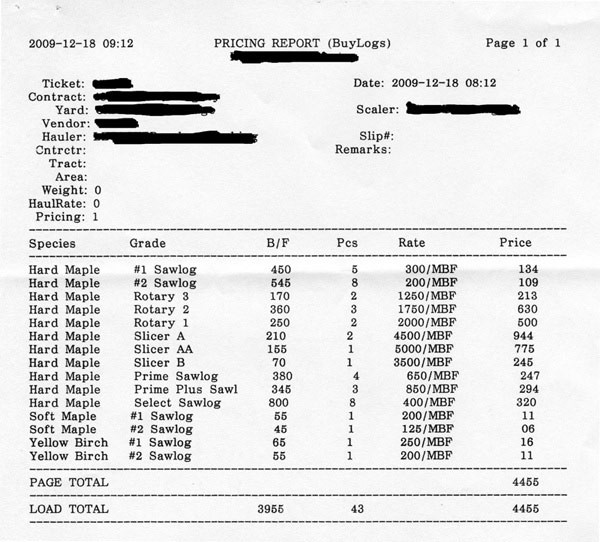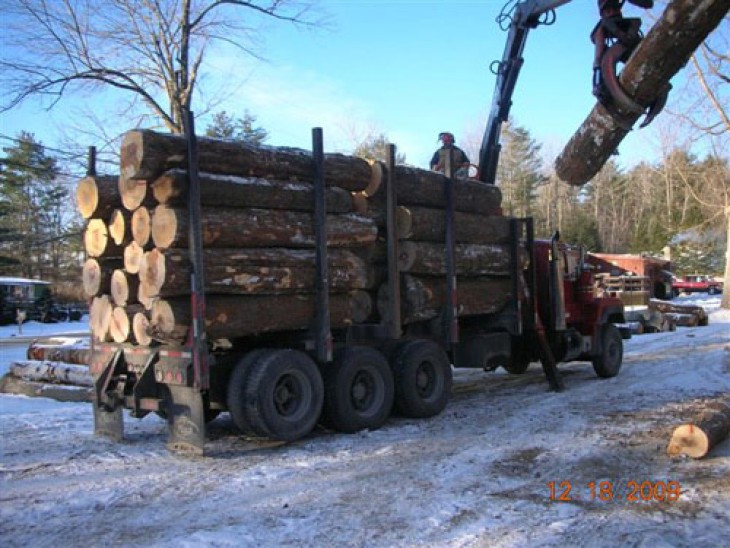
In December, 2009, a few days after we published a story in our winter issue about wood industry woes and low mill prices, a logger in northern New England fired up his chainsaw and cut down a nice hard maple tree. How nice? The tree, henceforth known as the “golden maple,” was sold for $1,636. We stand by our winter story – while anecdotal evidence suggests that sawlog prices have ticked up slightly, they’re still at 20-year lows. The difference is that some veneer markets have remained strong through the recession, and some veneer mills are still paying handsomely for good wood.
Pricing Report
There are four human players in the golden maple story: the landowner, the forester, the logger, and the log buyer (also called a scaler). The landowner hired the forester to mark the trees that became the logs you see on this slip. Typically, a forester is paid either by the hour or a percentage of the sale; in this particular case, a 10 percent fee was agreed upon. The forester contracted with the logger to cut the timber, the logger agreed to work for $150/MBF. (MBF means a thousand board feet – the M is used so that tally sheets don’t get bogged down in zeros.) The logger did his own trucking, for which he was paid extra, and delivered the wood to the log buyer, who evaluated it and wrote him a check. The pricing report you see here is the receipt that the logger received from the log buyer.
Grade Column
The mostly nice maple logs on this tally sheet filled one log truck, a dangerous sight rumbling down the highway, since passing drivers who are wood-savvy can be easily distracted by loads of mostly nice maple logs. You can get a sense of this quality by looking at the grade column. There are many grades for a hardwood log, but on a basic level, it’s either a veneer log, a sawlog, or a low-grade log (think pallet log, pulp log, or firewood log). There’s no low-grade on this truck, and the sawlogs are marked as such, which means the “slicer” and “rotary” designations are veneer – picture blemish-free trees with tight bark and perfect posture. Slicer AA is the most valuable designation a log can get – sometimes you’ll see them on a log truck wrapped in bubble wrap (we’re teasing, but it doesn’t hurt to think of them this way). Slicer A and Slicer B are nearperfect, but have slight defects. The term slicer refers to the fact that the log will be cut into thin parallel slices when processed; rotary-grade veneer logs, which are somewhat less valuable than slicers, are peeled to make a continuous thin sheet of wood. Sawlogs are trees destined to be turned into boards, and they too vary widely in value. The nicest logs here are called prime plus, followed by prime, select, #1, and #2. Note the tremendous disparity between the Slicer AA log, valued at $775, and the #2 soft maple sawlog, which grossed a whopping $6.
Scaler
Before we get into a more detailed economic discussion, it’s important to point out that pricing doesn’t exist in a vacuum – it’s a judgment call, determined by a scaler. Scalers are trained to quickly determine how best to utilize a log; they also detect imperfections, including seams, knots, and sweeps, all of which affect the log’s scale (volume) and grade. In this case, the scaler was an independent log buyer who resold these logs to a mill or mills; in other cases, scalers work for a particular sawmill or veneer mill.
Slicer AA, Slicer A, Rotary 1 and Prime Sawlog
The golden maple tree contained four logs, each of which received separate grades. The butt log – it’s the first log up from the stump, and almost always the most valuable log in a tree – was 9 feet long and 20 inches in diameter on the small end. It’s the Slicer AA log you see listed here, and it contained 155 board feet. The second log was a 9-footlong, 18-inch-diameter, 125 BF log (remember: trees taper, so they get thinner as they go up). It represents one of the two Slicer A logs here. The third log was a 9-foot, 18-inch, 125 BF log graded Rotary 1, and the final log in the tree, up near the crown, was an 8-foot, 15-inch, 75 BF prime sawlog. We’re often asked by readers how many board feet are in a tree, and the golden maple can be helpful in this regard. When your logger/forester friends casually throw around the clinical phrase, “a thousand,” picture two slamming maple trees, about 24 inches at breast height, as containing around 1,000 board feet of wood.
Load Total
You’ll see from this load-total line that there were 43 logs on this log truck, which made up 3,955 board feet of lumber. The logger walked away from the scaling house with a check for $4,455. He deducted $276.85 for trucking, and took his cut – at $150/MBF he made $593.25. The forester received 10 percent and made $386. The rest went to the landowner, who netted $3,475.75. If we look at the golden maple specifically, the logger was paid $77.25 to cut, skid, and buck the tree and $36.05 to haul it to the receiving yard. On that one tree, the consulting forester made $156.00 and the landowner netted $1,399.60. Here we get into the vagaries of math, and the sometimes uncomfortable nature of raw capitalism. On the surface, it may seem to some that the disparity between the landowner’s net and the logger’s net on this valuable tree is disproportionately large. What these numbers don’t show are the other truckloads of low-grade lumber that came off the property. The loads without veneer logs in them also contained between 3,500 and 4,000 feet of lumber, but here the logger made out better than the landowner. For example, one load of low-grade logs contained 3,535 board feet; the logger made $528 to cut the trees and $218 to truck them, and the owner netted $233.10. The gross on these low-grade loads averaged about $139/MBF, which means the logger’s $150/MBF put him ahead percentage-wise. To account for the swings in value between low- and high-grade wood, some loggers insist on a sliding percentage scale, where they get a higher percentage of the mill price on low-grade wood, and a smaller percentage, but more dollars, on the nice stuff.
As for the forester’s role in the golden maple story, $156 for splashing some paint on a tree is a pretty good return, but it, too, is a somewhat deceptive figure that was skewed by this one tree. On the entire truckload of low-grade wood cited above, the forester made $25.90. There’s a healthy debate in forestry circles as to whether a percentage-based fee encourages high grading, and in some cases it undoubtedly does. Still, paying a forester by the hour is just not realistic in some cases, and a by-the-hour rate is rife with its own potential for dishonesty. Whether you’re hiring a forester or a doctor or a housepainter, the person’s reputation and a past history of quality work should be your guide.
It is our hope that this annotation helps landowners better understand the value of the trees growing on their woodlot and the relationship between the players in a timber sale. We hope that it shows not only the value of a smashing tree but also the value of managing a woodlot to improve its future growing potential. According to the forester, the golden maple tree on this woodlot had a number of offspring/siblings that could be even more valuable in another 10 years.


